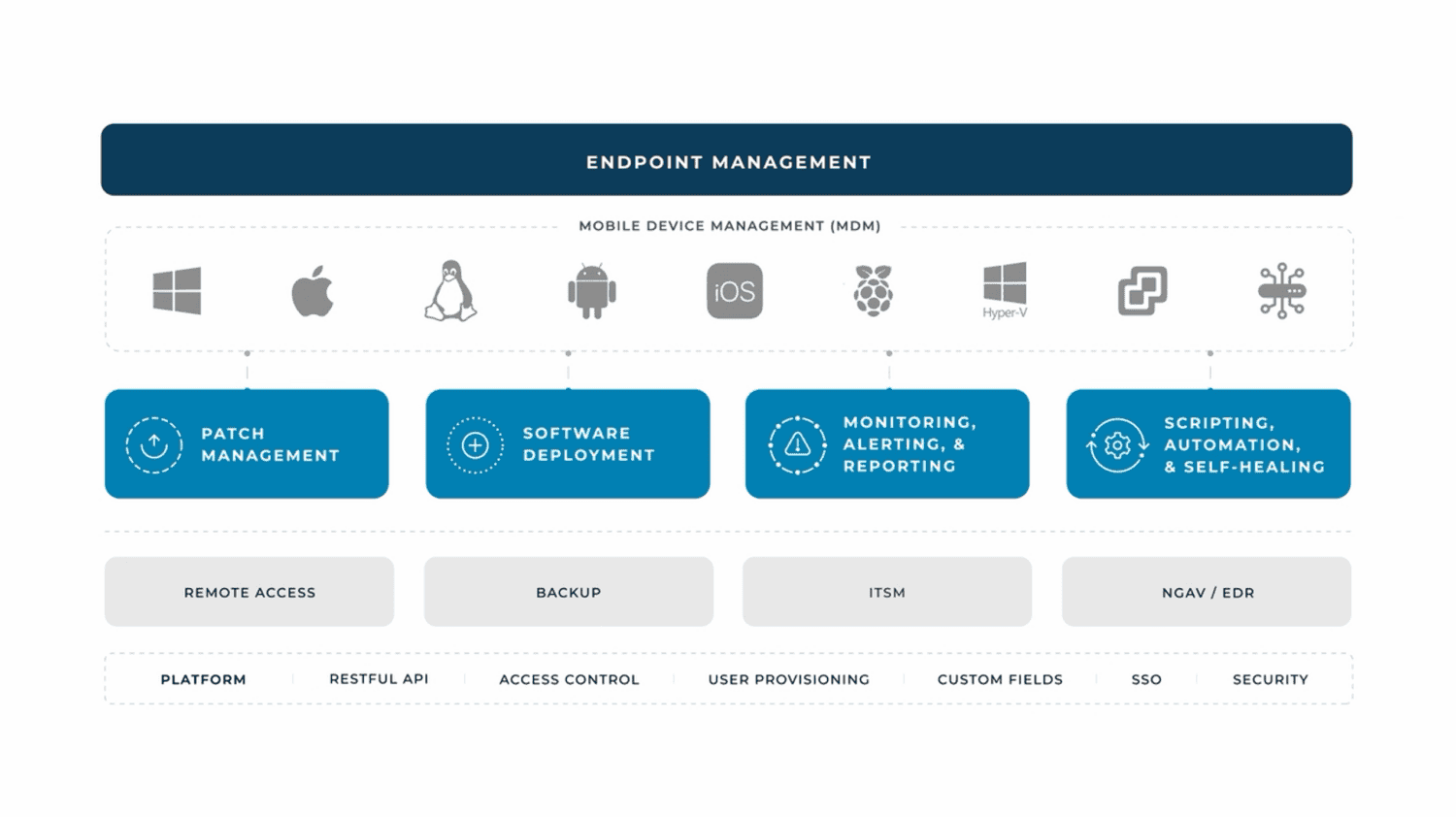In today’s work environment, mobile devices are essential. After all, a business or personal device enables work at any location. At the same time, this increasing number of mobile endpoints brings challenges, especially regarding management and security. How exactly can you address those challenges? We found out how NinjaOne Mobile Device Management (MDM) helps and how it works.
NinjaOne MDM, as the platform is called, comes at a time when hybrid working models are established. These modes of operation have seen a considerable rise and development in recent years. By now, it is well established that a full office or home-only work environment is not and will not become the norm for the knowledge worker. The IT department or managed service provider (MSP) doing the management must be able to respond to that reality and let employees use their preferred platform as much as possible. Whether it’s Android, iOS or iPadOS, they ideally use whatever makes an employee productive.
The job of the IT expert or MSP is to support this and manage and secure the mobile devices. That task is complex today because of the growth in the number of devices in use, NinjaOne sees. In addition to this increase in devices, managing often runs through multiple tools, leading to further inefficiencies. In theory, a focused solution could simplify work. This is precisely what NinjaOne MDM tries to achieve by taking the management of Android, iOS and iPadOS devices to the next level.
Extending existing capabilities
How NinjaOne MDM tackles this by extending the existing Endpoint Management product. Until recently, three endpoints were supported: workstations, laptops, and servers. The supported platforms are Windows, macOS, and Linux. By providing a single platform to manage and secure those three types of endpoints, NinjaOne has built a substantial market share in recent years. By also supporting Android and Apple mobile devices, it can provide additional capabilities and better support businesses.
Also read our earlier article covering how NinjaOne is changing endpoint management. That story is a good basis for placing the MDM extension discussed in this article.
By extending the existing product, IT teams and MSPs can now manage, patch, secure and support through a single console. The latter is essential because, for example, policies can be created, deployed and enforced towards devices all at once. This could include setting password requirements and device restrictions or automatically installing applications. NinjaOne says it is fairly easy to onboard into the platform if a new Android or Apple device is deployed in the corporate network or beyond. Thus, the console can constantly control the entire infrastructure’s management.
The obvious benefit of such an approach is standardization and efficiency in device management processes. Most knowledge workers may use personal mobile devices, making management essential to minimize operational disruptions.
Depth of MDM
The big question, though, is what sets NinjaOne MDM apart in the Mobile Device Management market. There are already quite a few products available, many of which have been embraced by longer-established companies. The principles NinjaOne stands for from its endpoint platform must be carried through to the new tool to be distinctive: advanced technology, user-friendliness and good support. Each characteristic must contribute to the most proactive management possible by the IT professional or MSP, keeping employees productive. To do this, NinjaOne MDM provides insights into individual mobile devices. This can include the health and connection status of the device, as well as which office the device is active in.

Remote management is one of the platform’s most critical technical aspects at the function level. This includes remote screen viewing between the user and IT for troubleshooting. IT teams can locate a device via geolocation, remotely lock or wipe it, and ensure that sensitive data remains protected if a device is lost or stolen. Herein is support for company-owned and bring your own devices (BYOD) that are onboarded. With such a feature, NinjaOne MDM can add value over competing tools.
One platform for all endpoints
Apart from such features, NinjaOne’s main strength is to manage all devices, from smartphones to servers, within a single interface. Indeed, this centralized management and visibility are crucial for maintaining security and improving efficiency. NinjaOne can now be a single solution for all endpoint management: Windows, macOS, Linux, Android, iOS, iPadOS, VMs and network environments. The integration of these endpoints eliminates the need for multiple management tools. This consolidation promises lower costs, reduced complexity and increased management and security efficiency.
NinjaOne can support this with own numbers. Statistics show that 82 per cent of NinjaOne customers were able to consolidate three to four tools. In addition, tool consolidation reduced licensing costs at 74 per cent of the companies, and those savings could reach 75 per cent, according to NinjaOne’s figures.
Changing IT management
Since most companies already have a tool running or simply a first tool, it is also good to consider what embracing NinjaOne MDM in the first phase would mean. NinjaOne promises a quick and easy implementation phase of the platform. This promise can be made because of the platform’s cloud-native architecture. Therefore, IT teams and MSPs can be up and running within days. There are no long learning curves often associated with implementing new technology. In addition, NinjaOne offers unlimited onboarding, training and support.
Overall, NinjaOne MDM can do plenty to address the challenges around managing mobile devices in the modern workplace. Combining technical features, user-friendly implementation, and business benefits, NinjaOne MDM enables organizations to increase efficiency and strengthen security. Centralizing the management of all devices within a single interface reduces complexity, which is a welcome benefit for IT teams and MSPs in an era of hybrid work.
